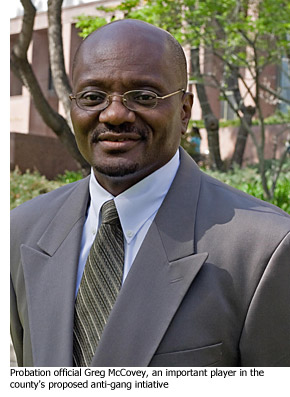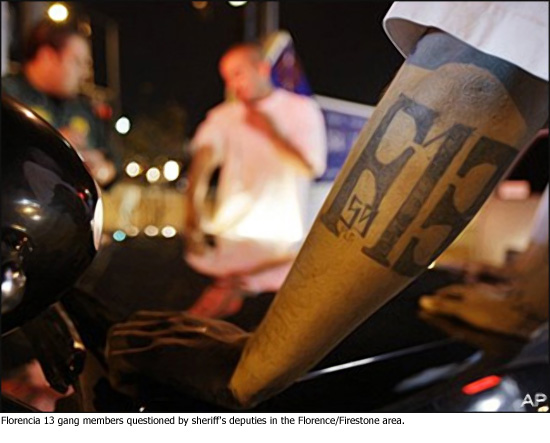A key man for a new gang plan [updated]
March 25, 2010
Pacoima is about to see a lot of Greg McCovey.
In this east San Fernando Valley neighborhood, the veteran probation official will soon become the point man for L.A. County’s long-awaited and multi-faceted anti-gang initiative, which the Board of Supervisors is scheduled to review on Tuesday.
Pacoima is one of four gang hotspots that, under the initiative, would be a testing ground for a new approach by the county, placing a much heavier emphasis on gang prevention, in addition to suppression. The other areas, spread across the county, are: Harbor Gateway, Monrovia/ Duarte and Florence/Firestone, home to one of the region’s most entrenched gangs, Florencia 13.
The $3-million plan—several years in the making—calls for a collaborative and coordinated effort among multiple county agencies to ensure that services are directed at juveniles who’ve been accused of gang membership and identified as high-risk for re-joining a gang. The services, which are designed to parallel stepped up law enforcement, also would be provided to families of these individuals.
The Chief Executive Office (CEO) is recommending to the board that, in each of the four targeted areas, the initiative would begin by focusing on 25 juvenile probationers whom the county will attempt to steer from the gang life by bolstering mental health, welfare and economic services. Overseeing each of those four areas will be a “site coordinator” directing several “work groups” responsible for specific facets of the strategy, including providing more parks and library services aimed at the larger community.
McCovey is the first—and, so far, the only—site coordinator selected.
A 20-year Probation Department veteran, he’s anxious to get to work. “This is a great opportunity to bring together a broad array of services to help the community and our (gang) families,” McCovey says. “It’s exciting.”
McCovey, 50, has a good resume for understanding and combating gang culture. In his last assignment in the Probation Department, he directed the intake decisions about where to send minors in juvenile halls throughout the county. Before that job, McCovey directed the Probation Department’s post-release programs from juvenile camps, so he’s seen what happens when gang probationers re-enter the community.
For the past year, McCovey has been on loan to the CEO’s office to help refine the county’s gang plan. He spent time exploring all four neighborhoods in the pilot project, meeting with residents and community groups. And within the next few weeks, he’ll begin interviewing the families of Pacoima probationers to determine which 25 juveniles are at high risk for returning to gangs unless they—and their families—get help.
Pacoima is unique among the four areas because it falls entirely within the City of Los Angeles, McCovey says. That will make some aspects of his job easier because the city already has instituted its gang prevention and patrol initiatives, which are serving as models for the county.
McCovey will work closely, for example, with Los Angeles’ Gang Reduction Youth Development program, the city’s own prevention effort, launched in 2007. The city’s Summer Night Lights program of nighttime soccer, basketball and cultural programs already is in place in Pacoima. The county plans to export similar programs to county parks in the other three demonstration areas.
McCovey says his greatest challenge may be to ensure that county agencies involved in the proposed anti-gang initiative can quickly bring their unique assets to the gang problem without duplicating efforts.
“There are a lot of different groups out there doing good work,” McCovey says, “and we don’t want to overlap.”
If the Board of Supervisors gives a green light to the latest phase of the plan, McCovey expects to start full-time early next month. When not on the ground in Pacoima, he’ll be based in the CEO’s office downtown with the other soon-to-be-selected coordinators.
“I’m very aware of the barriers that kids face when they return home,” McCovey says. “What I want to do is break down those barriers to ensure they have every opportunity to succeed.”
Posted 3/25/10
Updated 4/6 /2010:
The Board of Supervisors unanimously approved the latest phase of the county’s long-anticipated gang reduction initiative after it was amended to modify personnel plans and costs. Among other things, the plan establishes pilot programs to better coordinate anti-gang strategies in four key neighborhoods plagued with gang issues.
Most of the changes Tuesday involved the four “site coordinators” of the pilot programs who would oversee the program in their areas and direct the delivery of services by county departments and local gang prevention groups.
Under the original plan, the coordinators potentially could be hired from several county departments playing key roles in the anti-gang initiative. The plan also included $871,000 for departments to “backfill” for individuals selected as site coordinators.
But an amendment introduced by Supervisor Michael Antonovich required that all four site coordinators be selected from the Probation Department because the plan, for now, focuses primarily on gang probationers. Supervisor Don Knabe proposed a second amendment that cut the money needed to back-fill for the coordinators, meaning the Probation Department would essentially have to absorb the costs.
Antonovich’s amendment also restricted the uses of $400,000 in gang prevention funding in county parks to exclude expenditures on field trips, food and prizes and other items with no direct bearing on gang reduction.













 405 bridge work causes a stink
405 bridge work causes a stink
